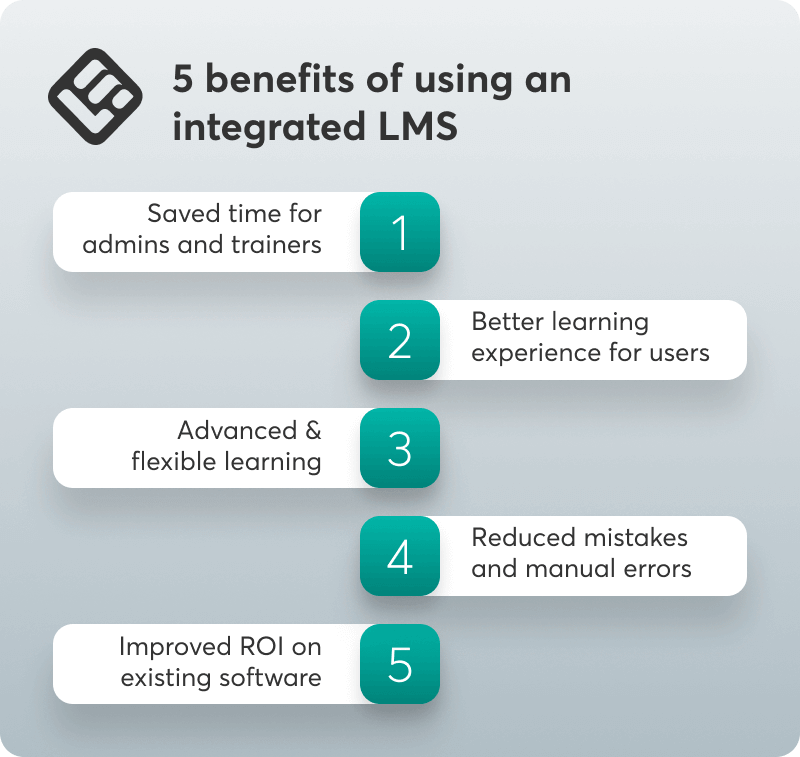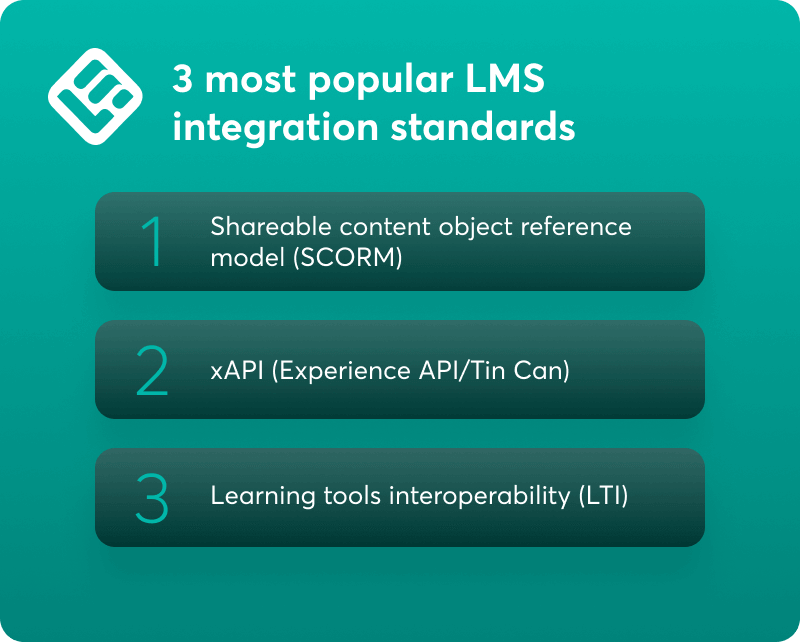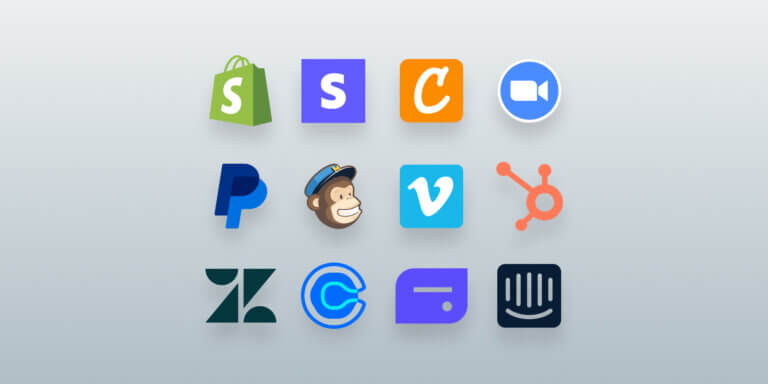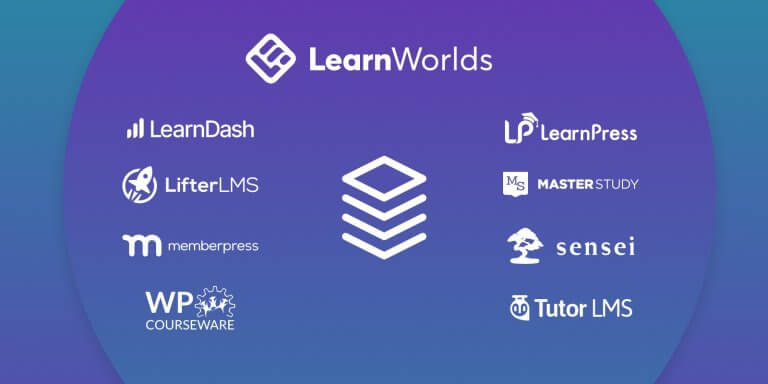Table of Contents
If you’ve ever tried to balance a dozen browser tabs just to organize a single online course, you understand why I’m all about making the most out of LMS integrations.
I know firsthand how stitching together the right tools can transform a clunky, time-consuming system into an amazing experience for both admins and learners.
I’m going to discuss what true integrations with learning management systems (LMS) look like, why they’re such a big deal, and what options you have.
The following table of the top 20 LMS integration tools for 2025 provides an overview of these types of LMS integrations, including their ratings and main reasons for using them.
What is an LMS integration?
An LMS integration is the act of connecting your learning management system with other tools so you can share data and automate processes across different platforms. This enables your LMS to send and receive data to and from other apps in your tech stack, cutting the time needed for redundant operations and eliminating manual data entry.
What is the difference between an API and an integration?
An API (Application Programming Interface) is a set of rules or protocols used to connect one application to another, determining how requests are structured so that one system can “communicate” with the other.
In contrast, an integration simply marks the larger process of setting up two or more disparate systems so they can “talk” to one another, share information, and operate in synergy with one another.
Simply, API is the technical way systems are integrated to share data, while integrations are the technical implementation of it all.
The benefits of using an integrated LMS
Want to improve your learning process or create efficiency in terms of productivity and process? That’s exactly what integrating your LMS can do.

Here are a few more benefits of LMS integration before you give them a try.
Saved time for admins and trainers
You can easily onboard users, track training progress, and report in a fully automated way. No more manual data entry and never-ending operational tasks. Your trainers and admins will finally be free to focus on strategic work instead.
Better learning experience for users
Single sign-on (SSO), merged dashboards, and access to multiple resources without having to go from one system to another. Sounds like a dream, but these are real advantages for learners.
Using multiple platforms synchronously is also proven to reduce barriers to access, lead to higher attendance, and reduce dropout rates.
Advanced and flexible learning
Bring video conferencing, testing, and measurement tools in one place to power blended learning, individualized learning paths, and adaptive content delivery.
Reduced mistakes and manual errors
Automatic data syncing and app integration mean staff don’t need to re-enter and update information manually every time there’s a change. This leads to a lower risk of dealing with incorrect information and time lags.
Improved ROI on existing software tools
By making the most out of a successful LMS integration, you can add more value to your current tools without having to purchase duplicative tool sets. Plus, this comes with a guarantee that all your systems will be in sync with each other.
According to a Forrester study commissioned by AWS, data integration projects have generated a 33% ROI in public sector organizations. Increased service delivery, better decision making, and millions of dollars in cost savings from streamlined operations and reduction in manual processes drove the benefits.
💡Read also: How to choose the best learning management software for your business in 2025
Types of learning management system integrations
But let me be clear: There’s quite a lot of LMS integrations to choose from. You won’t need all of them. Instead, pick your core and most pressing needs and choose accordingly:
Not all intergtations are available in just any LMS, so before you decide to buy go through their own list of integrations they offer.
Top 20 must-have LMS integration tools for 2025
Let’s explore some real options for LearnWorlds integrations.
Stripe
Stripe lets you take payments with ease anywhere directly on your LMS, with subscriptions, one-time, and multi-currency tools.
PayPal
Trusted by many successful online learning providers, PayPal enables a secure and user-friendly payment option, making it easier for learners to pay for courses/sessions or even subscriptions, with invoicing and recurring features in the mix.
Shopify
Through the LearnWorlds-Shopify integration, you can access ecommerce functionalities to sell courses, books, and even bundles, as well as facilitate and manage transactions from your online storefront.
Quaderno
Quaderno automatically handles taxes for digital sales so you can generate compliant invoices.
Zoom
Zoom is perfect for live virtual classrooms, webinars, and meetings directly from your LMS.
Calendly
Calendly and LearnWorlds are a real lifesaver duo for booking coaching, tutoring, or live sessions. They even help you avoid the back and forth, suggesting times that don’t work.
Microsoft Teams
Microsoft Teams improves teamwork and communication by helping you create a collaborative learning space within your LMS.
Vimeo
Vimeo lets you share high-quality, ad-free videos you can embed and track anywhere.
Wistia
Wistia provides deep video engagement metrics and branded video players for interactive coursework.
Accredible
Accredible makes it easy for you to automate the issuing of digital certificates and badges, and even say a quick “congrats” when learners succeed.
Credly
Credly offers digital credentials so learners can share verified skills and certifications across their professional networks.
HubSpot
Connect your LearnWorlds LMS with marketing automation and CRM tools from HubSpot to simplify lead management, email marketing, and learner segmentation.
Zendesk
With Zendesk, you can incorporate customer service and support right into your LMS, including ticket submission to help resources.
Tawk.to
With live chat support, learners get answers in real time, which translates into greater satisfaction and retention from using the Tawk.to integration with LearnWorlds.
Mailchimp
Mailchimp integration lets you improve your email marketing campaigns with automatic course updates, newsletters, and reminders.
ActiveCampaign
ActiveCampaign is similar to the Mailchimp-LearnWorlds integration as it offers an advanced marketing automation system so you can deliver personalized learning journeys and learner engagement campaigns.
Intercom
Intercom provides in-app messaging and support to help you onboard new learners and answer questions when they come up.
Google Search Console
Google Search Console is perfect if you need to keep an eye on your LMS website’s search performance and visibility.
Google Analytics 4
Pick this Google Analytics 4 LMS integration to get insights into how learners behave, course engagement, and conversions.
ReferralCandy
ReferralCandy is a great addition that automates rewarding existing students for inviting other students to join your online courses or academy.
How to ensure that you have an integrated learning management system
Start by identifying what you want your LMS to do.
Consider the day-to-day processes of your team. What variety of content do you provide? Are there any other systems they use on a daily basis?
By focusing on smooth data flow and automations, you can save time, decrease errors, and provide a much better experience for administrators and learners alike.
💡Read also: LMS implementation: The guide plan for your business success in 2025
Once you know what kind of integration you want, it’s time to implement things incrementally. As you do this, you want to keep the shareholders in the loop, test every integration, and monitor their performance and user feedback.
Grab my checklist to help you test this process for your next integration:
💡Read also: 10 best LMS for small businesses
💡Looking for the best LMS? Find out how LearnWorlds compares with other platforms:
How to overcome common learning management system integration challenges
More success also means working strategically and collaboratively to address technical and human issues alike. Below are some common issues you might experience.
Data compatibility and interoperability
The biggest struggle I face is integrating the LMS with other systems and making them “talk” to each other without being cumbersome. This often requires standardized APIs or ready-made add-ons to make data exchange easier and evaluate data formats.
Technical integration
Adapting to legacy technologies or platforms from other providers generally causes compatibility problems. You can overcome this by selecting an LMS with a solid API and getting your team members with technical expertise on the case early.
Data migration
Course and learner record transfer from old systems is difficult and error-prone. You need an organized migration plan and data audits to confirm accuracy.
User acceptance
Resistance to change can be tough when some people are used to your old system or are unwilling to learn a new platform. Personally, I’m all about investing in easy training, interactive onboarding, and continued support. That’s exactly how you can encourage adoption and improve acceptance.
Security and compliance
Learner privacy isn’t debatable. So, strong encryption and regulation compliance must be on your to-do list.
How the integration of learning management systems and analytics platforms enhances elearning
Advanced LMS integrations that rely on extensive analytics and machine learning can offer access to descriptive, predictive, and prescriptive analysis. This means educators can identify at-risk students, personalize learning, and improve grade achievement across a range of students.
In fact, the worldwide LMS market is projected to reach $25.7 billion by 2025, driven in part by the rising need for data-powered, personalized learning experiences.
A peer review study revealed the effects of incorporating big data analytics in an LMS on student performance. In this study, one group of students used an LMS with analytics-generated reports while another received the lectures via a learning platform, without analytics.
The findings revealed that students using data-informed information were substantially more successful academically than those who weren’t using it. This suggests that analytics within an LMS benefits not only in monitoring learners’ progress but also in keeping up with the needs of people with different learning styles.
That’s not the only proof that LMS integrations can help. Here’s what other experts say.
Integrating our LMS data with a strong business intelligence platform is one of the most useful LMS integrations for making operations run more smoothly. I was amazed by the insights that came to light when we first connected our learning management system to our BI dashboard. We were able to add the training completion data from our LMS to our usual sales metrics and customer satisfaction scores. Teams that had finished certain product training modules kept 25% more customers than teams that hadn’t.
Ryan McDonald, COO at Resell Calendar
The most successful applications of LMS are those that reduce the list of steps that are involved in sequencing and streamlining the process i.e. effective not only on the side of the instructors but also on the learners. The onboarding of our users has also become easier as we have made sure that our LMS will be able to accept a secure payment gateway such as Stripe. They can apply and deposit the same and they do not wait to get it and the application system is not manual either. The integration that was carried out once saved the support tickets and made sure that the students were impressed better on the first look.
Brian Clark BSN, MSNA, Founder and CEO / Certified Registered Nurse Anesthetist at United Medical Education
By connecting your LMS to other CRM platforms such as Salesforce or HubSpot, you will make sure that training data will be directly linked to the customer-facing departments. This eradicates the input of data manually and gives straightforward views on how the learning of the employees influences the customer relations and the outcomes of businesses. Also, it is possible to integrate the course with such applications as Slack or Microsoft Teams to increase learner engagement through the possibility to communicate in real-time, promptly receive course updates, and collaborate with peers.
Ben Richardson, CEO & Owner at Acuity Training
What are LMS integration standards and why do they matter?
LMS integration standards are predefined agreements or specifications that guarantee learning management systems will be able to connect, cooperate with, and share data with other tools.
And that matters. Because when you have your standards outlined, you can grow.
Following these also reduces technical hurdles, cuts integration costs, and guarantees a more streamlined, reliable user learning experience.

So what do they look like?
Shareable content object reference model (SCORM)
SCORM (Shareable Content Object Reference Model) describes the packaging and communication of online educational content within an LMS.
It means that the content generated on one system can be imported, launched, and tracked in any SCORM-compliant LMS. That’s great for structured learning and compliance training content.
xAPI (Experience API/Tin Can)
xAPI (also known as Experience API or Tin Can) is a more forward-thinking system that can track learning across other platforms besides just your learning platform. That includes mobile apps, simulations, and even real-world, in-person events.
💡Read also:
Learning tools interoperability (LTI)
LTI provides a mechanism for third-party tools, content, and activities to easily integrate into any LMS. With LTI, educators can incorporate external apps into the learning platform they’re using without requiring learners to contend with a juggle of logins.
LearnWorlds: The best choice for LMS integration
LearnWorlds is the ideal solution to access thousands of LMS integrations. It offers full access to plenty of third-party tools for marketing automation, ecommerce, communication and analytics. With support for industry standards such as SCORM, LearnWorlds will be there for you in delivering interactive content and staying connected with other learning tools.
Aside from its technical flexibility, LearnWorlds is built with end-user experience in mind: it provides easy navigation, a user-centric learning experience, a built-in AI Assistant, and advanced reporting. This means you can automate the mundane, gain keen insights about learner progress, and confidently scale your training programs.
Ready to refresh the digital learning journey you offer? Start a free trial today.

Alexandra Cote
Alexandra Cote is a SaaS growth marketer and online instructor who's worked with dozens of brands in the MarTech, HR tech, and productivity space. She's also a strong supporter of staying happy at work and choosing a healthy career path.
FAQ
Everything you have ever wondered, but were too afraid to ask...
The most popular LMS integrations in 2025 are HRIS tools like BambooHR and ADP, video conferencing tools like Zoom and Microsoft Teams, CRM systems like Salesforce, and productivity suites like Google Workspace and Microsoft 365.
These help onboarding run smoothly, keep user management processes automated, support live virtual training sessions, and ensure data flows smoothly between training and the business.
Regardless of industry, automating administrative tasks, customizing individual learning paths, and consolidating data for more digestible tracking and compliance are wins that LMS integrations get you.
Analytics and performance management tool integrations, in particular, create more individualized learning experiences, while video conferencing and collaboration tools integrations promote interactive, blended learning.
To choose the right LMS integrations, define your training requirements and look at your current tech stack. Pick integrations that align with your goals and business needs before all others.
When you weigh them out, think about how easy they are to adopt and how scalable they are, as well as what the user experience is like. Look into vendor support, compatibility with existing systems, and the ability to deliver content natively in multiple formats.




